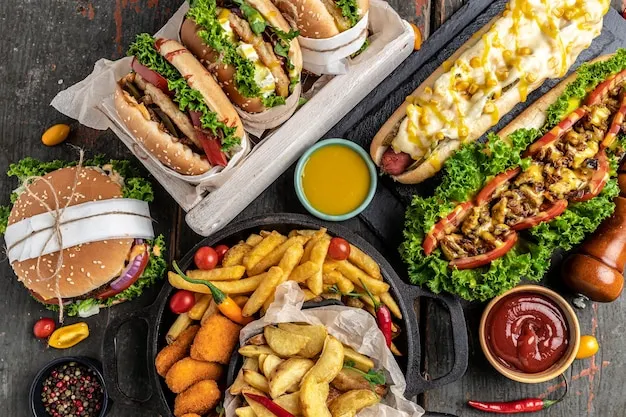Fast food has long been associated with unhealthy eating, excessive calories, and artificial ingredients. However, in recent years, the growing health-conscious movement has forced the fast food industry to change. Customers are now looking for healthier, cleaner, and more nutritious food options, and major brands are adapting fast. Let’s explore how fast food chains are shifting their strategies to cater to health-conscious consumers.
1. The Rise of Health-Conscious Consumers
- Increased Awareness: More people are becoming aware of the health risks of processed foods, high sugar intake, and artificial additives. Studies have linked excessive consumption of fast food to obesity, heart disease, and diabetes, prompting more consumers to seek healthier alternatives.
- Demand for Transparency: Consumers now expect clear labeling, organic ingredients, and nutritional details for every meal they order. Many are turning to brands that disclose ingredient sourcing and avoid artificial preservatives.
- Changing Lifestyles: With the rise of fitness trends, plant-based diets, and clean eating, fast food chains must adapt or lose customers. Health apps and wearable fitness devices have further influenced consumer choices, encouraging them to track their dietary intake and opt for healthier meals.

2. Healthier Menu Options
a) More Plant-Based and Vegan Choices
- Many fast food chains are now offering plant-based alternatives to burgers, nuggets, and even dairy products.
- Brands like McDonald’s, Burger King, and KFC have introduced plant-based meat options like the Impossible Whopper and Beyond Meat burgers.
- The demand for dairy-free and vegan cheese alternatives is also on the rise, with companies launching oat milk-based ice creams and nut-based cheeses.
- Some restaurants have even started offering entirely plant-based menus to attract vegan and vegetarian customers.
b) Lower-Calorie Meals
- Fast food chains are reducing portion sizes and offering lower-calorie meal options.
- Many companies are incorporating grilled, baked, or air-fried options instead of deep-fried foods, significantly reducing fat and calorie intake.
- Calorie counts are now displayed prominently on menus to help customers make informed decisions.
- Some brands are offering “build-your-own” meal options, allowing customers to control their calorie intake by choosing healthier ingredients.
c) More Nutrient-Rich Ingredients
- There is an increasing use of whole grains, lean proteins, and fresh vegetables in fast food items.
- Healthier oils like olive oil and avocado oil are replacing trans fats and hydrogenated oils, reducing cholesterol levels in meals.
- Natural sweeteners like honey and stevia are replacing refined sugar in beverages and desserts, helping consumers maintain stable blood sugar levels.
- Many brands are now fortifying their food with vitamins and minerals to enhance nutritional value, catering to customers looking for functional foods that promote overall health.

3. Transparency and Ingredient Sourcing
- Clean Labeling: Brands now highlight the absence of artificial preservatives, colors, and flavors in their food, reassuring customers about the quality of their meals.
- Locally Sourced Ingredients: Some fast food chains are partnering with local farmers to ensure fresh, organic, and non-GMO ingredients, reducing carbon footprints and supporting local economies.
- Ethical Sourcing: Many brands focus on sustainable fishing, free-range poultry, and ethically sourced coffee and tea, responding to consumer concerns about environmental impact and animal welfare.
- Third-Party Certifications: Fast food chains are increasingly seeking USDA organic, Non-GMO Project Verified, and Fair Trade certifications to establish credibility in the health-conscious market.
4. Tech-Driven Customization
a) AI and Personalized Orders
- Customers can now customize their meals using mobile apps, choosing healthier ingredients and substitutions.
- AI-driven recommendations help users pick options based on their dietary preferences, allergens, and caloric goals.
- Some apps even integrate with fitness trackers to suggest meals that align with personal health goals.
b) Nutritional Calculators
- Many fast food brands provide online nutritional calculators, allowing customers to plan their meals based on calories, macros, and allergens.
- Some restaurants have interactive kiosks that allow customers to adjust portion sizes and ingredients to customize their meals.
c) Smart Vending Machines and Kiosks
- Smart kiosks in restaurants offer health-focused recommendations and allow customers to filter out unhealthy options.
- AI-driven vending machines stocked with nutritious snacks are emerging in airports, malls, and workplaces, providing convenient yet healthy options.

5. Low-Sugar and Zero-Calorie Beverage Trends
- Fast food chains are reducing their reliance on sugary sodas by offering natural fruit juices, infused water, and sugar-free drinks.
- Many brands are introducing probiotic-rich drinks like kombucha and kefir to cater to gut health-conscious consumers, promoting digestion and immune function.
- Some chains now offer herbal teas and organic coffee as healthier alternatives to sugary lattes and energy drinks.
- Functional beverages with added vitamins, collagen, and antioxidants are becoming more common, appealing to wellness-focused customers.
6. Expansion of Gluten-Free and Allergen-Free Choices
- The demand for gluten-free, dairy-free, and nut-free meals has led brands to offer allergy-friendly menus, ensuring inclusivity for those with dietary restrictions.
- Dedicated preparation areas in kitchens help prevent cross-contamination for people with food sensitivities.
- Chains like Chipotle and Panera Bread now provide detailed allergen information and gluten-free alternatives, offering safer dining experiences for customers with food allergies.
- Some fast food brands are partnering with nutritionists to develop allergen-free menu items that still taste great.
7. The Role of Fitness and Wellness Influencers
- Social media influencers are playing a big role in promoting healthier fast food choices by sharing their experiences and recommendations.
- Many brands are partnering with fitness bloggers and nutritionists to promote their healthier menu options, boosting their credibility in the health-conscious market.
- Viral TikTok and Instagram posts often showcase fast food ‘hacks’ to make meals healthier, such as swapping fries for side salads or choosing grilled protein options.
- Some brands collaborate with influencers to develop limited-edition, health-focused menu items that appeal to their followers.
8. The Future of Healthy Fast Food
- Sustainable Packaging: More brands are using biodegradable and eco-friendly packaging to appeal to environmentally conscious consumers and reduce plastic waste.
- AI-Driven Menu Innovation: AI and machine learning will continue to help brands develop better nutritional options based on consumer preferences, ensuring that healthier choices remain appealing and accessible.
- Global Trends Influence: Fast food chains are integrating global health trends, such as Mediterranean, Japanese, and Nordic diets, into their menus, offering fresh, wholesome, and culturally diverse options.
- Increased Focus on Mental Health: Some fast food brands are introducing adaptogenic ingredients, like ashwagandha and turmeric, to support stress relief and cognitive function.
Final Thoughts
Fast food is no longer just about convenience; it’s evolving to meet the demands of health-conscious consumers. With cleaner ingredients, better transparency, and more nutritious options, the industry is proving that fast food and healthy eating can coexist. If these trends continue, the fast food industry will look completely different in the next decade!
12 Irresistible Regional American Dishes You Must Try Before You Die





